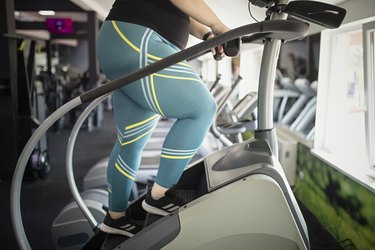
You've probably heard the suggestion to take stairs instead of escalators and elevators to help meet your step goals, and that's a great way to increase your daily movement. But steps are also a great addition to your gym routine.
The stair stepper provides a great workout for your quads and entire posterior chain (glutes, hamstrings, calves, lats, rhomboids and erector spinae muscles), but you may be surprised to learn it also engages your core and upper body too.
Video of the Day
Video of the Day
When using the stair stepper, stand up nice and tall as opposed to slouching over the railings or holding on and leaning back (this is especially easy to do when you're tired). Slightly pinch your shoulder blades together to help you stand upright and engage your upper back muscles as well.
If you hold on to the railings, you will engage your upper body, but you want to be careful not to grip too tightly. There should only be minimal tension in the hands. Tension in the body takes energy that is needed for the steps.
If you choose not to the hold on the the railings, keep your arms at a 90-degree angle and drive your elbows back to help power you up the stairs — this will also help you keep your balance. To engage the core more, with each step you take, think about lifting your leg up from your abdomen, verses leading with your quad muscle.
Tip
If you choose not to hold on to the railing, make sure you hinge forward from the hips a bit to help keep your balance and activate your hamstrings.
This 20-minute stair stepper routine consists of intervals starting strong, then decreasing the time in higher heart rate zones with active recovery. In the second half you will build back up to longer times in higher heart rate zones with active recovery. At the very end you will have a short burst of maximum effort before a full recovery.
Pick out a pumped-up playlist and get ready for a quick and challenging climb to the top!
Tip
Use your rate of perceived exertion (RPE) to help you determine the levels you should be using. RPE runs on a scale of 1 to 10 and helps you determine the difficulty of an activity. The higher the number, the more challenging the exercise.
In this workout, we're asking you to hit RPEs of 3, 5, 7 and 8 to 10. Here's how those should feel:
- RPE 3: Could easily hold a conversation. You're working, but not too hard.
- RPE 5: Noticeably challenging, but do-able. You could hold a conversation, but it would be hard.
- RPE 7: Very challenging. You could not say more than two or three breathy words.
- RPE 8 to 10: Out of breath. No talking at all!
20-Minute Stair Stepper Workout
Level | RPE | Time |
|---|---|---|
Begin at a level of an RPE of 3 (about level 4) | 3 | 1 Minute |
Increase level by 3 | 5 | 4 Minutes |
Increase level by 4 to 6 more | 7 | 90 Seconds |
Decrease level by 2 | 5 | 1 Minute |
Increase level by 3 to 4 | 7 | 1 Minute |
Decrease level by 3 to 4 | 5 | 1 Minute |
Increase level by 3 to 4 | 7 | 45 Seconds |
Decrease level by 3 to 4 | 5 | 1 Minute |
Increase level by 3 to 4 | 7 | 45 Seconds |
Decrease level by 3 to 4 | 5 | 1 Minute |
Increase level by 3 to 4 | 7 | 1 Minute |
Decrease level by 3 to 4 | 5 | 1 Minute |
Increase level by 3 to 4 | 7 | 90 Seconds |
Decrease level by 3 to 4 | 5 | 1 Minute |
Increase level by 5 to 6 | 8 to 10 | 30 Seconds |
Decrease level to beginning level | 3 | 2 min |